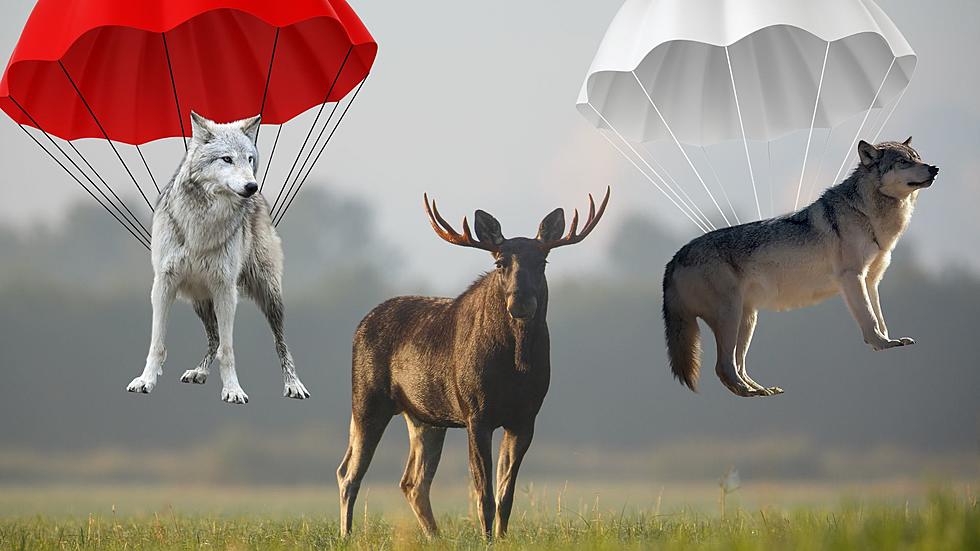
Remember When: Wolves Air-Dropped On Isle Royale To Control Moose Population
I came across this history lesson the other day and couldn't get the visual out of my head. It simply read, "Wolves Air-Dropped in US National Park to Deal with Moose." It made it sound like some secret task force mission to "dispose" of of all the moose on the island.
Turns out, that's not far from the truth, but a lot less like Jason Bourne, or Mission Impossible than my brain made it out to be. it was for necessary population control.

Isle Royale and its Moose
Michigan's northern-most land mass is Isle Royale. It sits on Lake Superior, just off the coast of Minnesota and Canada. It's one of the country's most isolated National Parks, and only sees about 25,000 people visiting every year.
Aside from park personnel, there are not permanent human residents on the island, however, there is a large population of other animals, including moose.
Originally, the island didn't have any moose. Mostly small animals were trapped there over centuries of freezing waters and land movement. Scientists guess the moose swam across a narrow stretch of Lake Superior from Minnesota in the early 1900s, and have flourished ever since... maybe TOO well.
At one time, there were more than 2,500 moose on the island, and had it not been for a sudden rise in the number of wolves on the island in the late 90s and early 2000s, that number could have become much higher.
But as the 2000s moved on, wolf populations declined again, and the moose began to grow again. And as big as moose get, they need a lot of food.If their population isn't kept in check, then they could strip the island of most of its edible flora, hurting other animal populations in the park.
The Royal Isle Wolves
Researchers knew wolves were introduced to the island some time around 1949. They believe a single pair crossed an ice bridge from Ontario and started breeding. But sadly, inbreeding didn't make the pack very viable.
Packs were small, and had growing health concerns over the decades. But, researchers observed one wolf dubbed "Old Gray Guy" crossing an ice bridge onto the island in 1997 that may have saved what population was still there.
He quickly took over one of the packs, and at the time, the island was only averaging about 23 wolves. Within two years, he had produced 23 pups, and those pups produced an additional 45 pups.
It was estimated that more than half the wolves on the island (around 50) descended from "Old Gray Guy" by 2009, and every wolf had descended from a single female from almost 70 years ago.
The population grew, and was more viable in the early 2000s. For a time, five packs lived on the island, but that number fell to only three in the early 2000s - The East Pack, The Middle Pack, and the Chippewa Harbor Pack. What's worse, the packs would fight to expand their territories and supply of moose. This resulted in the death of the alpha male of the Chippewa Harbor Pack in 2006.
Researchers didn't think the pack would survive, and again, wolf numbers declined rapidly on the island, while moose numbers began to rise again.
Rescue Wolves
The wolf population declined so dramatically, it was estimated in 2017 that only one or two wolves remained on the island, and there was no viable way to sustain their population with just the two wolves.
So, in 2018, they proposed some help. The National Park Service settled on relocating 20-30 wolves to the island over a three-year time frame.
At the end of 2018, three females and a male were trapped in Minnesota and brought to the island, but that proved unsuccessful. The male died, and all three females left the island via the ice in the winter.
But a group of 11 wolves brought in 2019 changed everything.
Trapped in Canada, they were air-dropped on the island, and within hours, reformed their pack, and began hunting. After a winter study in 2021 and 2022, it was estimated that there were now 28 wolves on the island, which is what specialists say is a viable number to help control the moose population.
It was also a completely new gene pool, which should help diversify the wolves as they break out and form new packs on the island.
So in a way, yes, this was a task force plan to "handle" the moose on Isle Royale. But for good reason.





